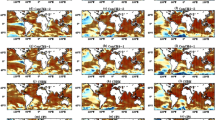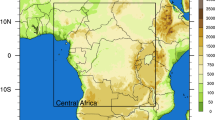Abstract
In the present study, the efficacy of the North American Multi-Model Ensemble (NMME) seasonal prediction models initialized by February month in simulating the climatological features and inter-annual variability of Summer (March through May; MAM) Surface Air Temperature (SSAT) over India is validated with the observations during 1981–2018. Among the six models, the CanCM4i model can capture the observed increasing trend of maximum, minimum, and mean temperatures over the Indian landmass with slight variation (trend values: 0.84 °C/38 years, 1.1 °C/38 years, and 0.96 °C/38 years). But, statistical analysis reveals that the CanCM4i model has more clod bias than the rest of the models (with less mean bias and RMSE) and in good agreement (slightly) with the observations. Most of the NMME models unable to simulating the extremely warm and cold events over the Indian region. Around 20–30% of extreme events are captured well like in the observations than in the normal years (high threat score). Furthermore, the dominant leading modes (by EOF1 and EOF2) of climate variability over India indicate that all NMME models underestimate (overestimate) the total variance of the first (second) dominant mode of SSAT than the observation except the Gem-NEMO model. Gem-NEMO model has a better total variance for EOF1 (63.84%) and EOF2 (11.23%) than other models. The IC3 (IC3-CanCM4, IC3-CanSIPS, IC3-Gem5-NEMO) models reasonably captured the association between principal component-1 and sea surface temperature (SST) anomalies over the eastern Pacific and positively over the south Atlantic region as in the observations. The NMME models have shown the SST anomalies over the eastern Pacific, Indian, and Atlantic Oceans, which are against to the observations except for the Gem-NEMO model. Thus, there is a large diversity in the representation of climatology features, inter-annual variability, and two dominant modes of variability of SSAT over India in present generation coupled seasonal prediction models.














Similar content being viewed by others
Data availability
NMME models output initialized by February (FEBIC) is available from https://iridl.ldeo.columbia.edu/SOURCES/.Models/.NMME/. Monthly maximum and minimum temperature data downloaded from CRUv4.04 https://crudata.uea.ac.uk/cru/data/hrg/cru_ts_4.04/cruts.2004151855.v4.04/.
Monthly SST data is available from OISST (https://www.psl.noaa.gov/data/gridded/data.noaa.oisst.v2.html). GPCP data is available from https://psl.noaa.gov/data/gridded/data.gpcp.html. Monthly zonal and meridional winds at 850 hPa obtained from ERA-interim (https://www.ecmwf.int/en/forecasts/datasets/reanalysis-datasets/era-interim).
Code availability
Not applicable.
References
Adler RF, Sapiano M, Huffman GJ, Wang J, Gu G, Bolvin D, Chiu L, Schneider U, Becker A, Nelkin E, Xie P, Ferraro R, Shin DB (2018) The Global Precipitation Climatology Project (GPCP) Monthly Analysis (New Version 2.3) and a review of 2017 global precipitation. Atmosphere (Basel) 9(4):138. https://doi.org/10.3390/atmos9040138 (Epub 2018 Apr 7. PMID: 30013797; PMCID: PMC6043897)
Attada R, Dasari HP, Jasti, et al (2018) Surface air temperature variability over the Arabian Peninsula and its links to circulation patterns. https://doi.org/10.1002/joc.5821
Berrisford P, Dee DPKF, Fielding K, Fuentes M, Kallberg P, Kobayashi S, Uppala S (2009) The ERA-interim archive. ERA Rep Ser (1):1–16
Chowdary JS, John N, Gnanaseelan C (2014) Interannual variability of surface air-temperature over India: impact of ENSO and Indian Ocean Sea surface temperature. Int J Climatol 34:416–429. https://doi.org/10.1002/joc.3695
Croitoru AE, Piticar A, Ciupertea A-F, Roşca C (2016) Changes in heat waves indices in Romania over the period 1961–2015. Glob and Planet Change 146:109–121. https://doi.org/10.1016/j.gloplacha.2016.08.016
de Dee DP, Uppala, Simmons, Berrisford, Poli P, Kobayashi S, Andrae U, Balmaseda M, Balsamo G, Bauer, Bechtold, Beljaars, van Berg L, Bidlot J, Bormann N, Delsol, Dragani R, Fuentes M, Vitart F (2011) The ERA-Interim reanalysis: configuration and performance of the data assimilation system. Q J R Meteorol Soc 137:553–597. https://doi.org/10.1002/qj.828
Gill AE (1980) Some simple solutions for heat-induced tropical circulation. Q J R Meteorol Soc 106:447–462
Halpert MS, Ropelewski CF (1992) Surface temperature patterns associated with the Southern Oscillation. J Clim 5:577–593. https://doi.org/10.1175/1520-0442(1992)005%3c0577:STPAWT%3e2.0.CO;2
Hansen J, Sato M, Ruedy R, Lo Kw, Lea D, Medina-Elizalde M (2006) Global temperature change. Proc Natl Acad Sci U S A 103:14288–14293. https://doi.org/10.1073/pnas.0606291103
Hansen JR, Ruedy R, Sato MLI, Lo KW (2010) Global surface temperature change. Rev Geophys 48:RG4004. https://doi.org/10.1029/2010RG000345
Harris I, Osborn T, Jones P, Lister D (2020) Version 4 of the CRU TS monthly high-resolution gridded multivariate climate dataset. Sci Data 7https://doi.org/10.1038/s41597-020-0453-3
Hasanean H (2004) Wintertime surface temperature in Egypt in relation to the associated atmospheric circulation. Int J Climatol 24:985–999. https://doi.org/10.1002/joc.1043
Hasanean HM, Basset HA (2006) Variability of summer temperature over Egypt. Int J Climatol 26(12):1619–1634. https://doi.org/10.1002/joc.1321
Hu T, Sun Y, Zhang X (2017) Temperature and precipitation projection at 1.5 and 2°C increase in global mean temperature. Chinese Sci Bull 62:3098–3111. https://doi.org/10.1360/N972016-01234
IPCC (2018) Summary for Policymakers. In: Global Warming of 1.5°C. An IPCC Special Report on the impacts of global warming of 1.5°C above preindustrial levels and related global greenhouse gas emission pathways, in the context of strengthening the global response to the threat of climate change, sustainable development, and efforts to eradicate poverty [Masson-Delmotte V, Zhai P, Pörtner H-O, Roberts D, Skea J, Shukla PR, Pirani A, Moufouma-Okia W, Péan C, Pidcock R, Connors S, Matthews JBR, Chen Y, Zhou X, Gomis MI, Lonnoy E, Maycock T, Tignor M, Waterfield T (eds.)] In Press
Kiladis G, Diaz H (1989) Global climate anomalies associated with extremes in the Southern Oscillation. J Clim 2:1069–1090. https://doi.org/10.1175/1520-0442(1989)002%3c1069:GCAAWE%3e2.0.CO;2
Kirtman BP, Min D, Infanti JM, Kinter JL, Paulino DA, Zhang Q, Wood EF (2014) The North American Multimodel Ensemble: phase-1 seasonal-to-interannual prediction; phase-2 toward developing intraseasonal prediction. Bull Am Meteorol Soc 95:585–601. https://doi.org/10.1175/BAMS-D-12-00050.1
Knowlton K, Kulkarni S, Azhar G, Mavalankar D, Jaiswal A, Connolly M, Nori-Sarma A, Rajiva A, Dutta P, Deol B, Sanchez L, Khosla R, Webster P, Toma V, Sheffield P, Hess J, Group, The (2014) Development and implementation of South Asia’s first heat-health action plan in Ahmedabad ( Gujarat, India). Int J Environ res Public Health 11:3473–92. https://doi.org/10.3390/ijerph110403473
Kothawale D, Munot AA, Kumar K (2010) Surface air temperature variability over India during 1901–2007, and its association with ENSO. Clim Res 42:89–104. https://doi.org/10.3354/cr00857
Lin H, Merryfield W, Muncaster R, Smith G, Markovic M, Dupont F, Roy F, Lemieux J-F, Dirkson A, Kharin V, Lee W-S, Charron M, Erfani A (2020) The Canadian Seasonal to Interannual Prediction System Version 2 (CanSIPSv2). Weather Forecast 35https://doi.org/10.1175/WAF-D-19-0259.1
Matsuno T (1966) Quasi-geostrophic motions in the equatorial area. J Meteorol Soc Jpn 44:25–43
Mazdiyasni O, AghaKouchak A, Davis S, Madadgar S, Mehran A, Ragno E, Sadegh M, Sengupta A, Ghosh S, Dhanya CT, Niknejad M (2017) Increasing probability of mortality during Indian heat waves. Sci Adv 3:e1700066. https://doi.org/10.1126/sciadv.1700066
Nageswararao MM, Mohanty UC, Kiran Prasad S, Osuri KK, Ramakrishna, SSVS (2016) Performance evaluation of NCEP climate forecast system for the prediction of winter temperatures over India. Theor Appl Climatol 126(3):437–451. https://doi.org/10.1007/s00704-015-1588-6
Nageswararao MM, Sinha P, Mohanty UC, Mishra S (2020) Occurrence of more heat waves over the central east coast of India in the recent warming era. Pure Appl Geophys 177:1143–1155. https://doi.org/10.1007/s00024-019-02304-2
Newman M, Alexander MA, Ault TR et al (2016) The Pacific decadal oscillation, revisited. J Clim 29:4399–4427. https://doi.org/10.1175/JCLI-D-15-0508.1
Reynolds RW, Rayner NA, Smith TM, Stokes DC, Wang W (2002) An improved in situ and satellite SST analysis for climate. J Clim 15(13):1609–1625
Ropelewski C (1992) Predicting El Niño events. Nature 356:476–477. https://doi.org/10.1038/356476a0
Ross R, Krishnamurti T, Pattnaik S, Pai D (2018) Decadal surface temperature trends in India based on a new high-resolution data set. Sci Reports 8https://doi.org/10.1038/s41598-018-25347-2
Shu-Yue YIN et al (2020) Mid-summer surface air temperature and its internal variability over China at 1.5° C and 2° C global warming. Adv Clim Change Res 11.3:185–197
Sutton R, Dong B, Gregory J (2007) Land/sea warming ratio in response to climate change: IPCC AR4 model results and comparison with observations. Geophys Res Let 34https://doi.org/10.1029/2006GL028164
Thorne P (2015) Briefing: How do we know the globe has warmed? What do we know about why? Proceedings of the ICE - Forensic Engineering 168. 58-64https://doi.org/10.1680/feng.15.00003
Trenberth KE, Jones PD, Ambenje P, Bojariu R, Easterling D, Tank AK et al (2007) Observations: surface and atmospheric climate change. In Climate Change 2007: The Physical Science Basis. Contribution of Working Group 1 to the 4th Assessment Report of the Intergovernmental Panel on Climate Change. Cambridge University Press
UNFCCC (2015) Adoption of the Paris Agreement. Proposal by the President. Report No.FCCC/CP/2015/L.9/Rev.1.https://unfccc.int/sites/default/files/resource/docs/2015/cop21/eng/l09r01.pdf
Willmott CJ (1981) On the validation of models. Phys Geog 2:184–194
WMO (2020) WMO statement on the state of the global climate in 2019. Available online. https://public.wmo.int/en/our-mandate/climate/wmostatement-state-of-global-climate
Xu Y, Zhou BT, Wu J, Han ZY, Zhang YX & Wu J (2017) Asian climate change under 1.5–4 C warming targets. Adv Clim Change Res 8(2):99–107
Yadav R, Kumar K, Rajeevan M (2009) Increasing influence of ENSO and decreasing influence of AO/NAO in the recent decades over northwest India winter precipitation. J Geophys Res 114https://doi.org/10.1029/2008JD011318
Zhou MZ, Zhou GS, Zhou XM, Lü et al (2019) Projection of temperature and precipitation changes over China under global warming of 1.5 and 2°C. Acta Meteorol Sin 77(2019):728–744
Acknowledgements
We thank the Prof. U C Mohanty, IIT Bhubaneswar, School of Earth Ocean and Climate Sciences, Weather and Climate Prediction Lab, and Indian Institute of tropical meteorology (IITM) for providing computational power. We are very grateful to the institutions participating in the NMME multi-model ensemble operational system for giving the hind-cast experiment data (https://iridl.ldeo.columbia.edu/SOURCES/.Models/.NMME/). Python and PyFerret are used for preparing the plots of the manuscript. Finally, all observational data sources are duly acknowledged. Anonymous reviewers are acknowledged for their insightful comments and suggestions for improving the manuscript.
Author information
Authors and Affiliations
Contributions
All authors contributed to the study conception and design. NRK and DAR performed material preparation, data collection, analysis, and manuscript preparation. All authors commented on previous versions of the manuscript. All authors read and approved the final manuscript.
Corresponding author
Ethics declarations
Ethics approval
Not applicable.
Consent to participate
Not applicable.
Consent for publication
All authors give consent to the publication of all details of the manuscript.
Conflict of interest
The authors declare no competing interests.
Additional information
Publisher's note
Springer Nature remains neutral with regard to jurisdictional claims in published maps and institutional affiliations.
Supplementary Information
Below is the link to the electronic supplementary material.
Rights and permissions
Springer Nature or its licensor (e.g. a society or other partner) holds exclusive rights to this article under a publishing agreement with the author(s) or other rightsholder(s); author self-archiving of the accepted manuscript version of this article is solely governed by the terms of such publishing agreement and applicable law.
About this article
Cite this article
Karrevula, N.R., Ramu, D.A., Nageswararao, M.M. et al. Inter-annual variability of pre-monsoon surface air temperatures over India using the North American Multi-Model Ensemble models during the global warming era. Theor Appl Climatol 151, 133–151 (2023). https://doi.org/10.1007/s00704-022-04269-0
Received:
Accepted:
Published:
Issue Date:
DOI: https://doi.org/10.1007/s00704-022-04269-0




